The question naturally arises after a dramatic story’s conclusion, what happens next because of what happened before? This is sometimes known as the “and, so?” or more bluntly the “so what?” question.
My argument here, based on Scripture as best I understand it, is that Jesus Christ and the sacred Hebrew Tetragrammaton (YHWH) are the same Being, One in pre-incarnate action from Creation to working through Israel to present a witness to the Holiness of God and the inability of man despite any and all self-efforts to return himself to the pre-fall, Edenic condition. This horrific dilemma had as its drumbeat of sorrow death after death of human, highly sentient beings,seemingly failed and purposeless, and national Israel going through never ending cycles of faith / obedience, independence, pride, arrogance, falling to follow their own way, leading to exile and enslavement, repentance, restoration, faith / obedience, and the cycle begins ever again.
Further this oneness between the YHWH (Kurios, Lord, in Greek) and The Lord Jesus Christ (Christ being the Greek word for the Hebrew word Messiah), was exemplified in the Temple, in Christ, and after the Cross in the Holy Spirit now indwelling us ordinary but redeemed creatures.
This is an incredible truth that I believe is taught by the coherence of all the Bible. But, now, let’s turn to the “and, so?” question. Consider the below graphic: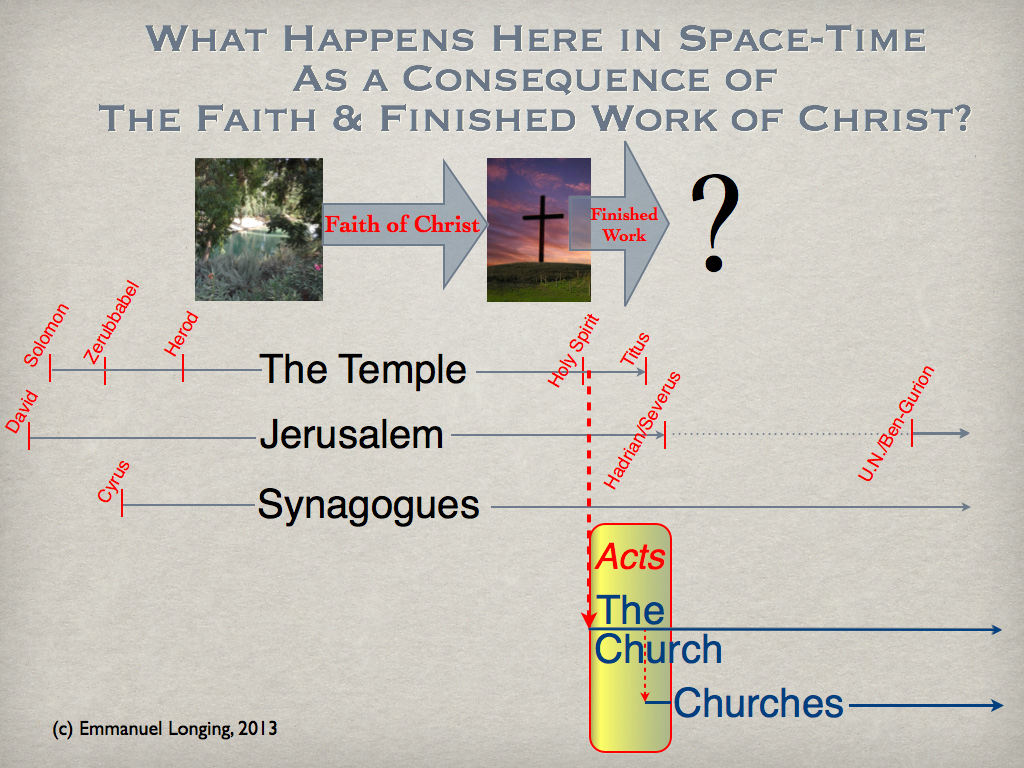 Summarized above, we see the big picture of the history of the Temple, the first one under Solomon, the second under Zerubbabel after the Babylonian exile, expanded by Herod the Great just before the time of Christ, the leaders of which rejected Jesus as the Messiah or even as a good man, and the destruction of the Temple in 70 A.D. by a Roman general named Titus. (There was a later complete annihilation of Jerusalem and all remnants of the Temple in 135 A.D. under another Roman general, Severus, under the then Emperor Hadrian, whereupon the Romans created a temple to their highest god, Jupiter, on the very spot of the Temple–a message for us all of what government really thinks of our faith). Since that time and to this day, there is no Temple, no sacrificial system, no priesthood.
Summarized above, we see the big picture of the history of the Temple, the first one under Solomon, the second under Zerubbabel after the Babylonian exile, expanded by Herod the Great just before the time of Christ, the leaders of which rejected Jesus as the Messiah or even as a good man, and the destruction of the Temple in 70 A.D. by a Roman general named Titus. (There was a later complete annihilation of Jerusalem and all remnants of the Temple in 135 A.D. under another Roman general, Severus, under the then Emperor Hadrian, whereupon the Romans created a temple to their highest god, Jupiter, on the very spot of the Temple–a message for us all of what government really thinks of our faith). Since that time and to this day, there is no Temple, no sacrificial system, no priesthood.
In an astonishing turn of events, Israel regained control of its land upon an act of the United Nations in 1948. In later wars, the Jewish people expanded its 1948 borders and gained control of Jerusalem to the Western Wall, the site with which we began this study. But the Temple Mount remains in control of the Moslem peoples, and their Dome of the Rock sits on or near where the Temple had once stood.
A Jewish institution that has survived is the local synagogue. This structure arose some time during the intertestment period, approximately 400 BC to the time of Christ, and has endured to the present day.
Jesus in the Gospel of John and in His Upper Room Discourse foretold that He would establish His Church. The early chapter of the Book of Acts records the sudden emergence in such a gather of called out ones in Jerusalem. Then as a result of persecutions, that early group of Believers were scattered into Samaria, Galilee and ultimately to the remotest parts of the world proclaiming the message of the Gospel. So, we quickly find events taking us from a single church–literally meaning an assembly of called out ones, to many local churches.
But was was, what is, the message that these churches possess? What is their duty to proclaim? Namely: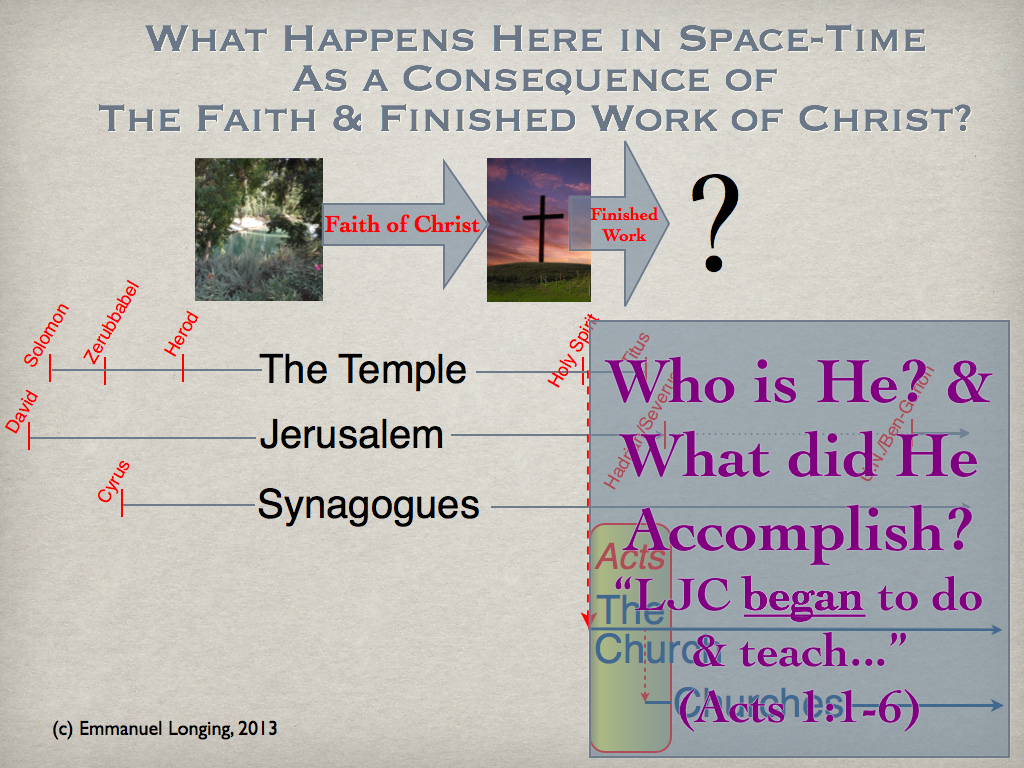 Consider the below claims some have made for this answer:
Consider the below claims some have made for this answer: Shown above is the first, and perhaps the most-obvious, and that is that Christ’s work pointed to a better Judaism, namely, that by / through Christ men could now keep the Law and establish their righteousness before God. The New Testament writing that most closely addresses this error is the Epistle to Galatians, where they have “fallen from Grace”–not into carnality as some might suggest but to its opposite, self-righteousness under law-keeping.
Shown above is the first, and perhaps the most-obvious, and that is that Christ’s work pointed to a better Judaism, namely, that by / through Christ men could now keep the Law and establish their righteousness before God. The New Testament writing that most closely addresses this error is the Epistle to Galatians, where they have “fallen from Grace”–not into carnality as some might suggest but to its opposite, self-righteousness under law-keeping.
Let’s consider another proposed answer to the purpose of the Work of Christ in the Church: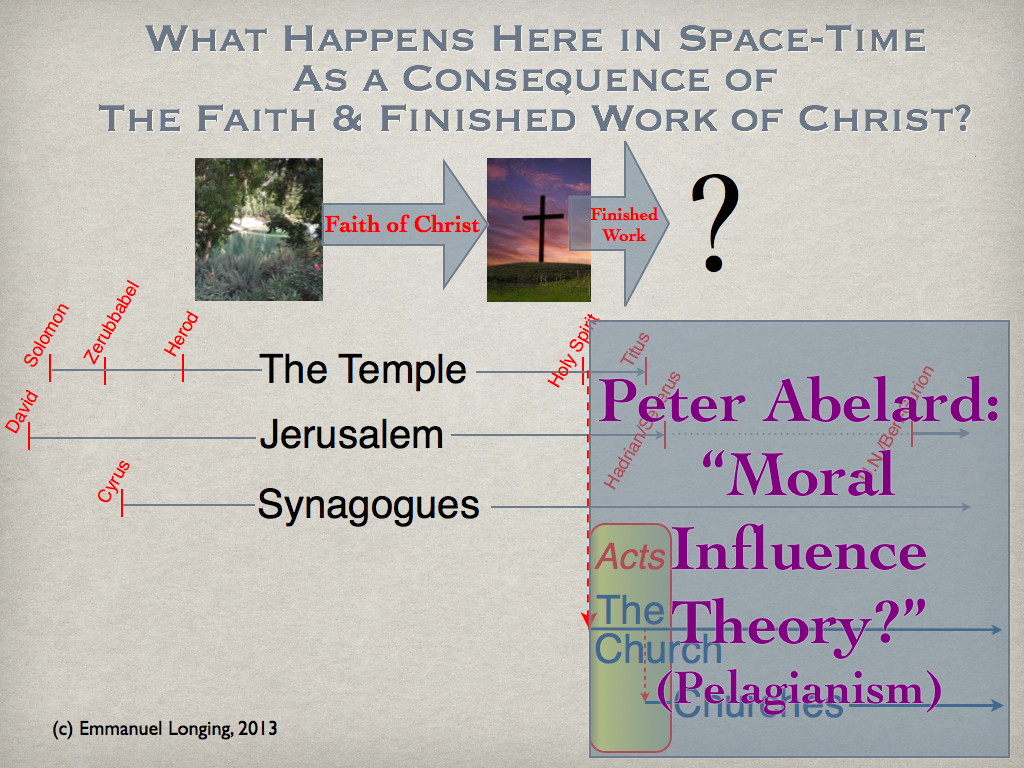 The above provides a nuanced but related alternative of a New Judaism, namely, that Christ was a moral influence for us, a perfect example, which we can follow and in so doing earned what He did.
The above provides a nuanced but related alternative of a New Judaism, namely, that Christ was a moral influence for us, a perfect example, which we can follow and in so doing earned what He did.
Below is another proposal: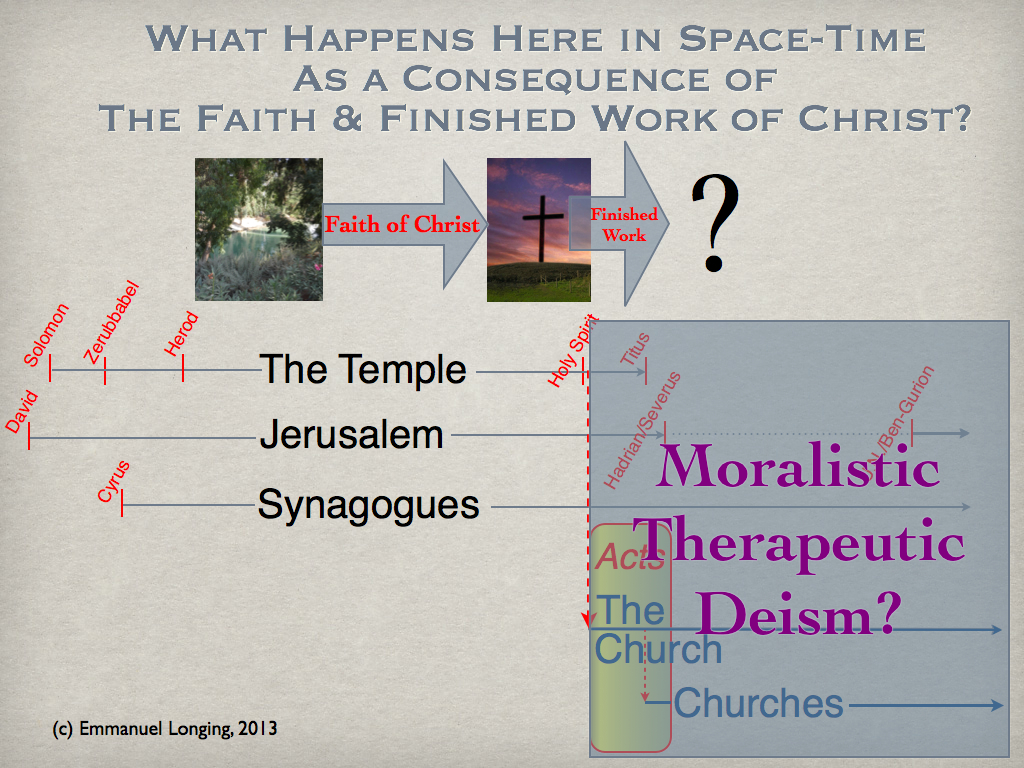 The above is essentially a modern Sadducean view, that we live in this world of broad opportunities to do and be good in so many different ways and arenas, no particular one is any more “right” than any other, as they all can lead up that glorious mountain of righteous attainment all while not being too extreme in self-confidence or humility or certainty, confident that in the end God will sort everything out properly not paying much attention to labels or to our inevitable slip sliding along the way. God is a very reasonable guy; He just happens to be hugely powerful.
The above is essentially a modern Sadducean view, that we live in this world of broad opportunities to do and be good in so many different ways and arenas, no particular one is any more “right” than any other, as they all can lead up that glorious mountain of righteous attainment all while not being too extreme in self-confidence or humility or certainty, confident that in the end God will sort everything out properly not paying much attention to labels or to our inevitable slip sliding along the way. God is a very reasonable guy; He just happens to be hugely powerful.
Below is yet another view: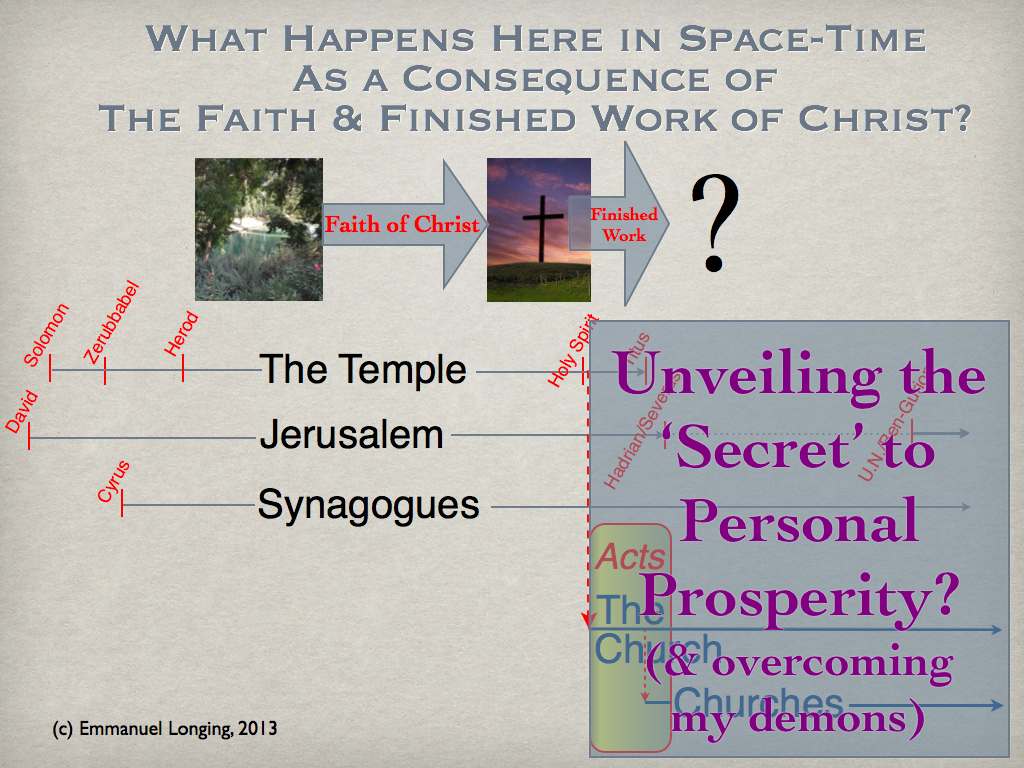 The above is very earth here and now centered. It claims that Christ makes it possible through His example and His ability to answer sincere prayer, which sincerity is particularly made evident by charitable giving to that happy-happy-face on the TV or behind a pulpit or microphone. Prosperity for me, under this system, may be just being rid of some particular ‘demons;’ for many others, there is much more at stake as there is a world of abundance that could be had by following certain ways of life.
The above is very earth here and now centered. It claims that Christ makes it possible through His example and His ability to answer sincere prayer, which sincerity is particularly made evident by charitable giving to that happy-happy-face on the TV or behind a pulpit or microphone. Prosperity for me, under this system, may be just being rid of some particular ‘demons;’ for many others, there is much more at stake as there is a world of abundance that could be had by following certain ways of life.
But, what does Scripture say? Consider the below: The above summarizes some of Christ’s teaching regarding this period of God’s working, after the Cross and Ascension, during the ministry of the Holy Spirit within the naos of each us Redeemed ones, awaiting for the return of Christ and the restoration of all things.
The above summarizes some of Christ’s teaching regarding this period of God’s working, after the Cross and Ascension, during the ministry of the Holy Spirit within the naos of each us Redeemed ones, awaiting for the return of Christ and the restoration of all things.
First, Christ taught us in His Upper Room Discourse, that there is now a New Covenant in His blood. This is much to reflect upon in this simple statement. If there is a New Covenant, then the Old one must be set aside. What was the Old Covenant? It was the obligation upon Israel (and converts) to conform to the Law of God–from the 10 Commandments to all the other laws and statutes conveyed by God under the Mosaic legal code. The Old Covenant conveyed God’s blessing conditionally to Israel, and to those who became followers of the God (YHWH) of Israel, adopting the Covenant and its signs (circumcision, Sabbath-keeping, feast-keeping of Passover, First Fruits, and Booths, etc.).
What is the New Covenant? Clearly it is the Gospel message of Christ having fulfilled the requirements of the Law which we never could and so conveyed upon us through Grace, the propitiation (favor / approval / satisfaction) on the part of the Father, redemption on our part, freeing us from slavery to both sin and the impossibility of self-salvation as any path to obtaining the holiness of God.
With the New Covenant (“Covenant” is just another word for “Testament”), the people are now both Jews and Gentiles. That is, Gentiles, as it were, have been grafted into the metaphoric vine used throughout the Old Testament as a picture of God’s Jewish people. In the Upper Room Discourse, Christ tells us that He is the vine and we are the branches; if / as we remain in Him we bear much fruit.
The final point in our brief introduction of the elements of the New Covenant is the “Church.” The Greek word translated “church” is “ek-klay-see-uh“–which meeting called out one (“Klay-see-uh” means “to call” and “ek” is out as in English “ex” is the ‘out’ command of our common word “ex-it”). So the physical Temple, and the special place of Jerusalem and even the Promised Land has been set aside in this Church age, replaced by the body of God’s redeemed / called out ones, who gather in all manner of settings, Jews and Gentiles, homes and buildings, formally and informally, Sunday or other special day or no special day.
And in the gatherings of the Church, we reflect upon the redemptive Work of Christ, which is what the Lord’s Supper (or Communion) is intended to remind us, and are taught unendingly the Christ-glorifying Old and New Testament.
Let us now think a little bit further about Christ and His Church.